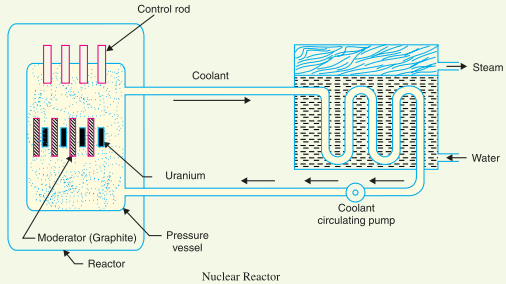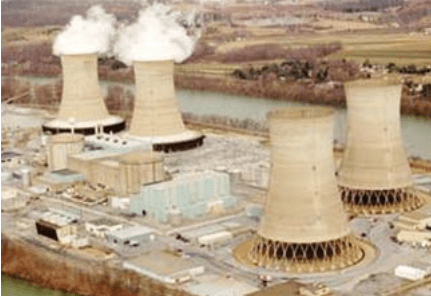Nuclear Power Station:
Here I am going to explain you the different types of power generating stations or power plant.First, let us know what is the function of a power generating station.A power generating station or power plant uses various sources like hydel energy, thermal energy, diesel, nuclear energy to produce bulk electric power.Here now we are going to discuss how the energy of radio active elements are used to generate power.So for that nuclear power station or nuclear power plant is employed.
A generating station in which nuclear energy is converted into electrical energy is known as a nuclear power station.In a nuclear power station, heavy elements such as Uranium (U235) or Thorium (Th232) are subjected to nuclear fission in a special apparatus known as a reactor. The heat energy thus released is utilised in raising steam at high temperature and pressure.The steam runs the steam turbine which converts steam energy into mechanical energy.The turbine drives the alternator which converts mechanical energy into electrical energy.
The most important feature of a nuclear power station is that huge amount of electrical energy can be produced from a relatively small amount of nuclear fuel as compared to other conventional types of power stations.It has been found that complete fission of 1 kg of Uranium (U235) can produce as much energy as can be produced by the burning of 4,500 tons of high-grade coal.
Although the recovery of principal nuclear fuels (i.e., Uranium and Thorium) is difficult and expensive, yet the total energy content of the estimated world reserves of these fuels are considerably higher than those of conventional fuels, viz., coal, oil and gas. At present, the energy crisis is gripping us and, therefore, nuclear energy can be successfully employed for producing low cost electrical energy on a large scale to meet the growing commercial and industrial demands.
Must Read :
Nuclear Power Station Schematic Diagram:
The whole arrangement can be divided into the following main stages :
(i) Nuclear reactor
(ii) Heat exchanger
(iii) Steam turbine
(iv) Alternator
(i) Nuclear reactor: It is an apparatus in which nuclear fuel (U235) is subjected to nuclear fission. It controls the chain reaction that starts once the fission is done.If the chain reaction is not controlled, the result will be an explosion due to the fast increase in the energy released.A nuclear reactor is a cylindrical stout pressure vessel and houses fuel rods of Uranium, moderator and control rods.
The fuel rods constitute the fission material and release a huge amount of energy when bombarded with slow moving neutrons.The moderator consists of graphite rods which enclose the fuel rods.The moderator slows down the neutrons before they bombard the fuel rods.The control rods are of cadmium and are inserted into the reactor.Cadmium is strong neutron absorber and thus regulates the supply of neutrons for fission.When the control rods are pushed in deep enough, they absorb most of the fission neutrons and hence few are available for chain reaction which, therefore, stops.
However, as they are being withdrawn, more and more of these fission neutrons cause fission and hence the intensity of chain reaction (or heat produced) is increased.Therefore, by pulling out the control rods, the power of the nuclear reactor is increased, whereas by pushing them in, it is reduced.In actual practice, the lowering or raising of control rods is accomplished automatically according to the requirement of the load. The heat produced in the reactor is removed by the coolant, generally a sodium metal.The coolant carries the heat to the heat exchanger.
(ii) Heat exchanger: The coolant gives up the heat to the heat exchanger which is utilised in raising the steam.After giving up the heat, the coolant is again fed to the reactor.
(iii) Steam turbine: The steam produced in the heat exchanger is led to the steam turbine through a valve.After doing a useful work in the turbine, the steam is exhausted to the condenser.The condenser condenses the steam which is fed to the heat exchanger through feed water pump.
(iv) Alternator: The steam turbine drives the alternator which converts mechanical energy into electrical energy.The output from the alternator is delivered to the bus-bars through the transformer, circuit breakers and isolators.
Selection of site for nuclear power station :
The following points should be kept in view while selecting the site for a nuclear power station :
(i) Availability of water: As sufficient water is required for cooling purposes, therefore, the plant site should be located where ample quantity of water is available, e.g., across a river or by sea-side.
(ii) Disposal of waste: The waste produced by fission in a nuclear power station is generally radioactive which must be disposed of properly to avoid health hazards.The waste should either be buried in a deep trench or disposed of in sea quite away from the sea shore.Therefore, the site selected for such a plant should have an adequate arrangement for the disposal of radioactive waste.
(iii) Distance from populated areas: The site selected for a nuclear power station should be quite away from the populated areas as there is a danger of presence of radioactivity in the atmosphere near the plant.However, as a precautionary measure, a dome is used in the plant which does not allow the radioactivity to spread by the wind or underground waterways.
(iv) Transportation facilities: The site selected for a nuclear power station should have adequate facilities in order to transport the heavy equipment during erection and to facilitate the movement of the workers employed in the plant.
Must Read :
From the above mentioned factors, it becomes apparent that ideal choice for a nuclear power station would be near sea or river and away from thickly populated areas.
Nuclear Power Station Advantages:
(i) The amount of fuel required is quite small.Therefore, there is a considerable saving in the cost of fuel transportation.
(ii) A nuclear power plant requires less space as compared to any other type of the same size.
(iii) It has low running charges as a small amount of fuel is used for producing bulk electrical energy.
(iv) This type of plant is very economical for producing bulk electric power.
(v) It can be located near the load centres because it does not require large quantities of water and need not be near coal mines.Therefore, the cost of primary distribution is reduced.
(vi) There are large deposits of nuclear fuels available all over the world. Therefore, such plants can ensure continued supply of electrical energy for thousands of years.
(vii) It ensures the reliability of operation.
Nuclear Power Station Disadvantages:
(i) The fuel used is expensive and is difficult to recover.
(ii) The capital cost on a nuclear plant is very high as compared to other types of plants.
(iii) The erection and commissioning of the plant require greater technical know-how.
(iv) The fission by-products are generally radioactive and may cause a dangerous amount of radioactive pollution.

